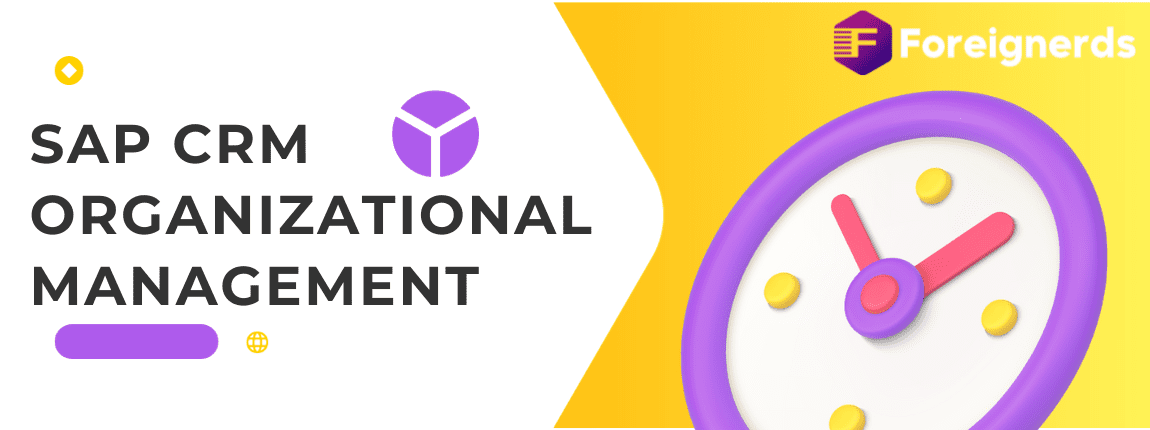In today’s fast-paced business landscape, customer relationship management (CRM) has become pivotal for organizations seeking to thrive in a competitive market. SAP CRM Organizational Management is a powerful tool that enables businesses to manage customer interactions efficiently while maintaining a well-structured organizational framework. In this article, we’ll delve into the depths of SAP CRM Organizational Management, exploring its significance, key features, implementation process, and the benefits it brings to businesses.
1. Introduction to SAP CRM Organizational Management
SAP
CRM Organizational Management is an integral part of the SAP Customer Relationship Management (CRM) module. It focuses on structuring an organization’s data to reflect its hierarchical structure and relationships between different entities. By doing so, businesses gain a comprehensive view of their organization, enabling better decision-making and improved customer service.
2. Why is Organizational Management Important?
Organizational Management is crucial because it lays the foundation for a seamless CRM experience. It ensures that the right individuals have access to the right information, leading to enhanced collaboration and efficiency within the organization. Additionally, it aids in the creation of targeted marketing campaigns and personalized customer interactions.
3. Key Features of SAP CRM Organizational Management
Hierarchy Management
SAP CRM Organizational Management allows businesses to define and manage their organizational hierarchy effectively. This includes creating organizational units, positions, and relationships between them, providing clarity on reporting structures.
Role-Based Access Control
Role-based access control ensures that employees have access to only the information and functionalities relevant to their roles. This enhances data security and reduces the risk of unauthorized access.
Relationship Mapping
With SAP CRM Organizational Management, organizations can map various relationships within their structure. This includes identifying who reports to whom and understanding the dynamics between different teams and individuals.
Reporting and Analytics
The system provides robust reporting and analytics capabilities, enabling businesses to gain insights into their organizational structure. This data can be used to identify bottlenecks, optimize processes, and make data-driven decisions.
4. Implementing SAP CRM Organizational Management
Implementing SAP CRM Organizational Management involves several crucial steps:
Pre-Implementation Planning
Before implementation, it’s essential to define clear objectives and requirements. This phase involves understanding the organization’s structure and determining how SAP CRM Organizational Management can align with its goals.
Configuration and Customization
During this phase, the system is configured to match the organization’s specific needs. Customizations may include defining roles, responsibilities, and access rights.
Data Migration
Migrating existing data into the system is a critical step. It ensures that historical information is retained and can be used for future reference and analysis.
Training and User Adoption
Proper training is essential to ensure that employees can effectively use SAP CRM Organizational Management. User adoption is crucial for the successful integration of the system into daily operations.
5. Benefits of Implementing SAP CRM Organizational Management
Improved Customer Service
By having a clear organizational structure and access to relevant customer data, businesses can provide more personalized and efficient customer service.
Enhanced Decision-Making
Data-driven insights obtained through it empower organizations to make informed decisions and adapt to changing market conditions.
Increased Efficiency
Efficiency gains are achieved by streamlining processes, reducing duplication of effort, and improving communication and collaboration within the organization.
6. Real-Life Use Cases
Several organizations have benefited from the implementation of SAP CRM Organizational Management. For example, Company XYZ saw a 20% increase in customer satisfaction after adopting the system.
7. Challenges and Solutions
While implementing it can be highly beneficial, it also comes with challenges such as data integration issues and resistance to change. These challenges can be addressed through proper planning and change management strategies.
8. Future Trends
The future looks promising, with advancements in artificial intelligence and machine learning expected to further enhance its capabilities. Automation and predictive analytics will play a more significant role in optimizing organizational structures.
Conclusion
In conclusion, it is a powerful tool that can
transform how businesses manage customer relationships and internal operations. By effectively structuring organizational data and utilizing the system’s features, organizations can achieve improved customer service, enhanced decision-making, and increased efficiency.
